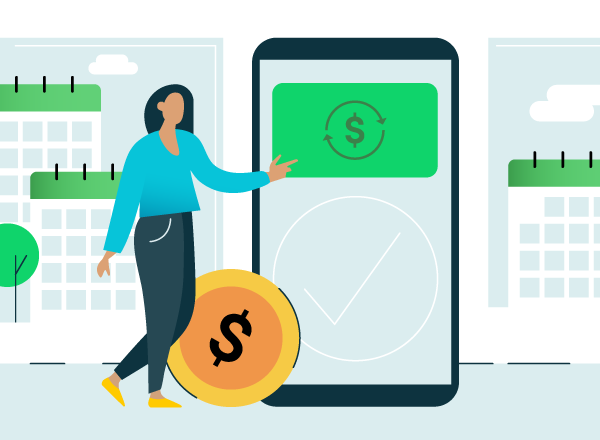

Payment must be made as soon as an invoice is received—usually by the next business day at the latest. Instead of asking customers to pay within a set period, like 30 days, putting “due upon receipt” tells them you expect payment as soon as possible.
Cash flow worries keep one out of every four business owners up at night. And for good reason—collecting payment from customers can be one of the more stressful business tasks.
Dealing with late payments or even non-payment is a challenge. One way to reduce this risk is by implementing invoice due upon receipt payment terms . By requiring payment when the invoice is received, you help ensure you get paid immediately and avoid the hassle of chasing down outstanding payments.
Let’s look at how and when to use due upon-receipt invoicing and its pros and cons:

As a business owner, you can set the invoice terms and conditions for payments. Whether you’re a solopreneur or someone running a medium-sized business, you should set invoice payment terms that best serve your business.
In general, due upon receipt invoicing is best for new clients or one-time clients. That way, you can wrap things up in one clean transaction. However, having invoices due upon receipt isn’t always recommended. It can cause friction with clients who are also trying to manage their own cash flow. You may want to consider other invoicing terms for clients that will need multiple orders or revisions.
Due upon receipt invoicing terms are good for one-off projects or new clients. It’s not ideal for multi-order projects or multiple invoices.
There are several advantages to using the due upon receipt payment term on your invoices. For example:
Due upon receipt invoicing can help make running your business a smoother process. However, it might not be as advantageous for your clients. Here are some notable disadvantages to consider:
Only you can decide which invoice payment method is best for your business. When selecting your invoice terms, consider relationship management .
Consider your relationship with the client, when deciding whether to use due upon receipt payment terms. Good payment history or rapport means you might want to be more flexible with payment terms to strengthen your relationship.
To maintain great relationships with clients, make sure to word your request for immediate payment appropriately. Use polite but direct language that stipulates payment due date and payment instructions.
Here are some tips on how to write a request for immediate payment:
An invoice requiring immediate payment should not come as a surprise. Clients should understand that payment is due upon receipt before signing the service contract.
Consider using bookkeeping services to help streamline your invoicing and payment collection process

Get help and guidance when you need it from real QuickBooks experts.*
Start hereInstead of setting your default invoicing payment term to due upon receipt, you could also use other payment terms. For example:
You can also offer incentives for early payment if you choose to use one of these invoicing terms instead. For example, you could offer a 2% discount if the customer pays within 10 days, known as 2/10.
Whichever payment terms you set, make sure to communicate the due date to the client. This makes it more likely that you’ll receive payment promptly. Plus, it helps you contest any disputes that may arise over past-due payments or non-payment.
With QuickBooks, you can set custom payment terms for each client or customer, as well as offer personalized discounts for early payment.
When invoicing, always make sure you have the invoice date and due date clearly labeled. You can also improve your billing process with these best practices:
Need to get paid fast but don’t need an invoice? You use QuickBooks payment links to request payment and let your customers choose a payment method that’s convenient for them.
If you’re having trouble collecting payments from your clients, changing your payment terms and having an invoice due upon receipt may be beneficial. As with any other business decision, weigh the pros and cons of using due upon-receipt payment terms for some or all of your clients.
Having a plan for invoicing can significantly streamline your workflow and reduce outstanding payments. Invoicing software like QuickBooks can help you set up and automate invoices and payments so you can focus more on critical business activities that will help you grow.
Underpaying an invoice on purpose is not considered illegal, but it is a dishonest business practice. Short-paying an invoice can happen by accident, however.
What is a fair late fee for invoices?Late fees for invoices are typically 1% to 2% of the outstanding balance.
What is an example of a sentence for an invoice?A good example of a sentence for an invoice is: Payment is due upon receipt of this invoice.
How do you invoice professionally?To invoice professionally, ensure your invoice includes the following information: Your business name and contact information, the invoice date and number, each product or service, the total amount due, and payment terms, such as the due date.
Recommended for you
How to collect outstanding payments: Best practices for small businesses

What is a recurring payment? Tips, types, and info to simplify billing
October 20, 2021

How to speed up payments: 20 tips to get clients to pay their bills and invoices faster
We provide third-party links as a convenience and for informational purposes only. Intuit does not endorse or approve these products and services, or the opinions of these corporations or organizations or individuals. Intuit accepts no responsibility for the accuracy, legality, or content on these sites.
**Product information
QuickBooks Live Assisted Bookkeeping: This is a monthly subscription service offering ongoing guidance on how to manage your books that you maintain full ownership and control. When you request a session with a Live Bookkeeper, they can provide guidance on topics including: bookkeeping automation, categorization, financial reports and dashboards, reconciliation, and workflow creation and management. They can also answer specific questions related to your books and your business. Some basic bookkeeping services may not be included and will be determined by your Live Bookkeeper. The Live Bookkeeper will provide help based on the information you provide.
QuickBooks Live Full-Service Bookkeeping: This is a combination service that includes QuickBooks Live Cleanup and QuickBooks Live Monthly Bookkeeping.
1. QuickBooks Online Advanced supports the upload of 1000 transaction lines for invoices at one time. 37% faster based off of internal tests comparing QuickBooks Online regular invoice workflow with QuickBooks Online Advanced multiple invoice workflow.
2. Access to Priority Circle and its benefits are available only to customers located in the 50 United States, including DC, who have an active, paid subscription to QuickBooks Desktop Enterprise or QuickBooks Online Advanced. Eligibility criteria may apply to certain products. When customers no longer have an active, paid subscription, they will not be eligible to receive benefits. Phone and messaging premium support is available 24/7. Support hours exclude occasional downtime due to system and server maintenance, company events, observed U.S. holidays and events beyond our control. Intuit reserves the right to change these hours without notice. Terms, conditions, pricing, service, support options, and support team members are subject to change without notice.
3. For hours of support and how to contact support, click here.
4. With our Tax Penalty Protection: If you receive a tax notice and send it to us within 15-days of the tax notice we will cover the payroll tax penalty, up to $25,000. Additional conditions and restrictions apply. See more information about the guarantee here: https://payroll.intuit.com/disclosure/.
Terms, conditions, pricing, special features, and service and support options subject to change without notice.
QuickBooks Payments: QuickBooks Payments account subject to eligibility criteria, credit, and application approval. Subscription to QuickBooks Online required. Money movement services are provided by Intuit Payments Inc., licensed as a Money Transmitter by the New York State Department of Financial Services. For more information about Intuit Payments' money transmission licenses, please visit https://www.intuit.com/legal/licenses/payment-licenses/.
QuickBooks Money: QuickBooks Money is a standalone Intuit offering that includes QuickBooks Payments and QuickBooks Checking. Intuit accounts are subject to eligibility criteria, credit, and application approval. Banking services provided by and the QuickBooks Visa® Debit Card is issued by Green Dot Bank, Member FDIC, pursuant to license from Visa U.S.A., Inc. Visa is a registered trademark of Visa International Service Association. QuickBooks Money Deposit Account Agreement applies. Banking services and debit card opening are subject to identity verification and approval by Green Dot Bank. Money movement services are provided by Intuit Payments Inc., licensed as a Money Transmitter by the New York State Department of Financial Services.
QuickBooks Commerce Integration: QuickBooks Online and QuickBooks Commerce sold separately. Integration available.
QuickBooks Live Bookkeeping Guided Setup: The QuickBooks Live Bookkeeping Guided Setup is a one-time virtual session with a QuickBooks expert. It’s available to new QuickBooks Online monthly subscribers who are within the first 30 days of their subscription. The QuickBooks Live Bookkeeping Guided Setup service includes: providing the customer with instructions on how to set up chart of accounts; customized invoices and setup reminders; connecting bank accounts and credit cards. The QuickBooks Live Bookkeeping Guided Setup is not available for QuickBooks trial and QuickBooks Self Employed offerings, and does not include desktop migration, Payroll setup or services. Your expert will only guide the process of setting up a QuickBooks Online account. Terms, conditions, pricing, special features, and service and support options subject to change without notice.